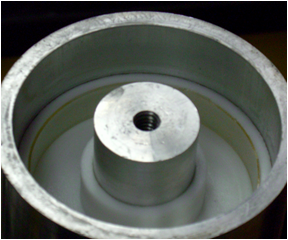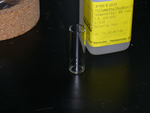
Preparation of slides an alignment or sacrificial layer is essential in preparation of aligned free standing films. Procedures for spin coating and preparing an alignment layer are described.

- balance
- weighing boat | paper
- glass vial | plastic > 5mL
- glass | plastic transfer pipette
- Teflon film (~20um thick)
- spin casting head
- heated centrifuge | spinning apparatus
- dry-ice | liquid nitrogen
- Tefzel tape (DuPont)
- 15 cm plastic | wood | metal rod for hanging LCE

This material is prepared using a heated centrifuge in a spin casting head. Before starting material preparation, pre-heat the spin casting head to 60 ~ 65oC.

The first step is preparation of the catalyst solution and reaction solution

- The platinum catalyst solution is prepared as a 1 to 2% weight/weight (w/w) solution in methylene chloride. Typically, this solution is prepared in quantities of 100 to 200uL in a brown vial and stored in the refrigerator.
- Example calculation for 1% (w/w)solution: Add 2 mg of the platinum catalyst to brown glass vial. Add methylene chloride drop wise until the total mass is 100 mg. This will be enough to prepare 5 batches of LCE


- Cut the glass slides to the desired size. 1cm x 1cm slides are routine, but larger slides may be cut. Use the glass cutter to score one side of the glass and gently break the slides.
- Place the cut slides in a slide holder or glass vial so that glass stands on end. Fill the slide holder with toluene so the slides are completely immersed in the solvent.
- Put the container in an ultrasonic bath and sonicate for 10 minutes.
- Cover the container with a Kim wipe or dust free cloth and pour out the toluene
- Immerse the slides in acetone, sonicate for 10 minutes, and pour off the acetone as described above
- Pour off the acetone, replace with methanol, sonicate for 10 minutes, pour off the solvent
- While still in the container, take the slides to a fume hood. Remove the glass from the container using tweezers and stand on edge to air dry the glass. Once dry, place in Petri dish or other covered container.
Spin coating
- Turn on the spin coater
- While wearing gloves, write on one side of the slides with a marker to identify which side has the coating. We use a backwards R. When the non-coated side of the slide is placed on the bench top, it reads as a normal R. See illustration to the right. Place the slide on the spin coater so one can read a normal R. This may be more easily understood by looking at the graphic to the right.
- Using a pipette, place 6 drops of either the PEOX or PVA solution on the center of the slide and spin for 1 minute. Add 6 more drops the sacrificial layer to the center of the slide and spin for 2 minutes. The second coat is crucial for a smooth layer. Larger slides will require more material.
- Immediately place the coated slide in a separate Petri dish. Be careful not to stack slides on top of each other or come in contact with the coating. The slides are now ready to use.











































